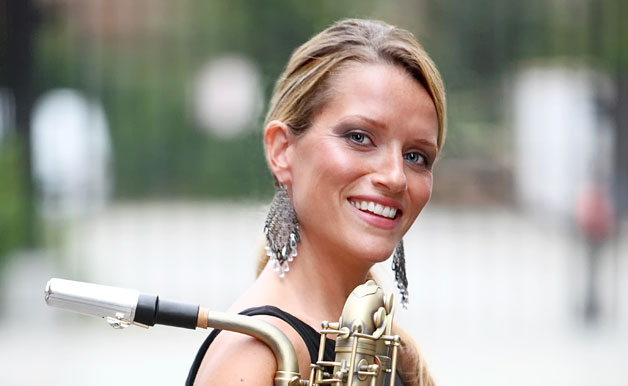Lauren Sevian on the Baritone Sax, Greg Osby, Patience, and More

The baritone sax doesn’t get as much love as it should, and that just plain ain’t right. There are a lot of reasons for this, but it’s always great to come across bari players who make the instrument burn and sing just as much as some of their most skilled counterparts on the smaller members of the saxophone family.
Lauren is one of those bari players. Kicking some serious bari-bootie as a teenager performing at venus such as Carnegie Hall, Lincoln Center and the Village Vanguard, Lauren has gone on to perform with The Mingus Orchestra, The Oliver Lake Big Band, The Artie Shaw Orchestra, the Grammy-nominated band, Travis Sullivan’s Bjorkestra, and so many more bands that your head would seriously spin if I attempted to list them all.
As a nominee for Downbeat’s “rising star” baritone saxophonist, Lauren is also establishing herself as a recording artist on Greg Osby’s label, Inner Circle where she released her compelling album, Blueprint.
The Interview
Doron Orenstein: What is it about the baritone that drew it to you over the more popular alto and tenor saxophones?
Lauren Sevian: I started on alto saxophone, later switching to baritone. I felt like something was missing, I knew that I wanted to play saxophone, but didn’t want to play alto or tenor (even though I listen to mostly tenor players!). I tried bari and it felt right to me, like I had found my voice.
DO: What are some of the most challenging aspects of playing bari sax as compared to the other saxophones?
LS: I would say it’s size, it’s easy to get tired because of the weight of it (not embouchure-wise). Also because of all the extra tubing you have to push the air through quite a bit faster than alto or tenor. Another challenge is just getting the instrument on the airplane! This certainly wasn’t something I considered when I picked bari.
DO: How did you end up connecting with Greg Osby and releasing an album on his label (Inner Circle Music)?
LS: I met Greg at a Vandoren jam session and we stayed in touch. He approached me about releasing a record on a label that he was starting up and of course I said yes. He definitely gave me the push I needed to release my first record.
DO: I see that you do a lot of teaching. In your experience, what are some of the most common challenges that young players have to overcome?
LS: I would say patience, which is something I try to emphasize. Sometimes young players want a certain gig or accolades immediately. We think we can have almost anything instantaneously without much work or research. Music is the total opposite. It’s a lifelong journey. We are all perpetual students, you don’t get to a point where you stop learning or practicing. If I ever did, I would give up.
DO: What do you find yourself practicing the most these days?
LS: Mostly tunes, standards that I haven’t had a chance to learn, or music for a specific gig. Giant steps in all twelve keys, Cherokee in all twelve keys.That never gets old for me! Transcribing a new tune, or solo. It keeps things fresh for me.
DO: Who are some of the new bari players on the scene who you recommend checking out?
Jason Marshall, Frank Basile, Andrew Hadro, Carl Maraghi, Paul Nedzela. I’m sure there are many more who I haven’t met yet!
DO: What non-jazz music are you listening to at the moment?
LS: I’m really into hip hop and rap, Tribe Called Quest, Pharcyde, Wu Tang Clan are my favorites. I’ve also been listening to some singers on the pop scene, mainly Adele & Sia.
Lauren’s setup:
Buffet-Crampon lacquer baritone, RPC mouthpiece (115 tip opening), Vandoren Optimum ligature, Rico reeds (strength 3,orange box)
For more info on Lauren, visit her website at www.LaurenSevian.com






March 5, 2011 @ 7:37 am
Yeah! I saw Lauren with the Mingus band the last time I was in NYC. She was tearing it up!
March 6, 2011 @ 10:51 am
Wow, that must have been cool. A lot of killn’ players in that band. Can never get me enough of Mingus. :)
March 7, 2011 @ 3:26 pm
Hey Lauren, don’t forget Countdown in all 12 keys! (It’s a family thing.)
Love,
Your Brother,
Greg
March 7, 2011 @ 8:07 pm
Hopefully Lauren is checking back, but if not, make sure you contact her directly to remind her so that she doesn’t slack!
Thanks for stopping by,
Doron
March 24, 2011 @ 6:50 am
Great read and great playing.
March 24, 2011 @ 7:00 am
Hey Evan,
Glad you dug it!
Doron
March 26, 2011 @ 9:13 am
Nice article on Lauren, she’s a great player .
Thanks !
March 26, 2011 @ 11:13 am
Hello David,
Lauren is a monster indeed!
Thanks for stopping by,
Doron